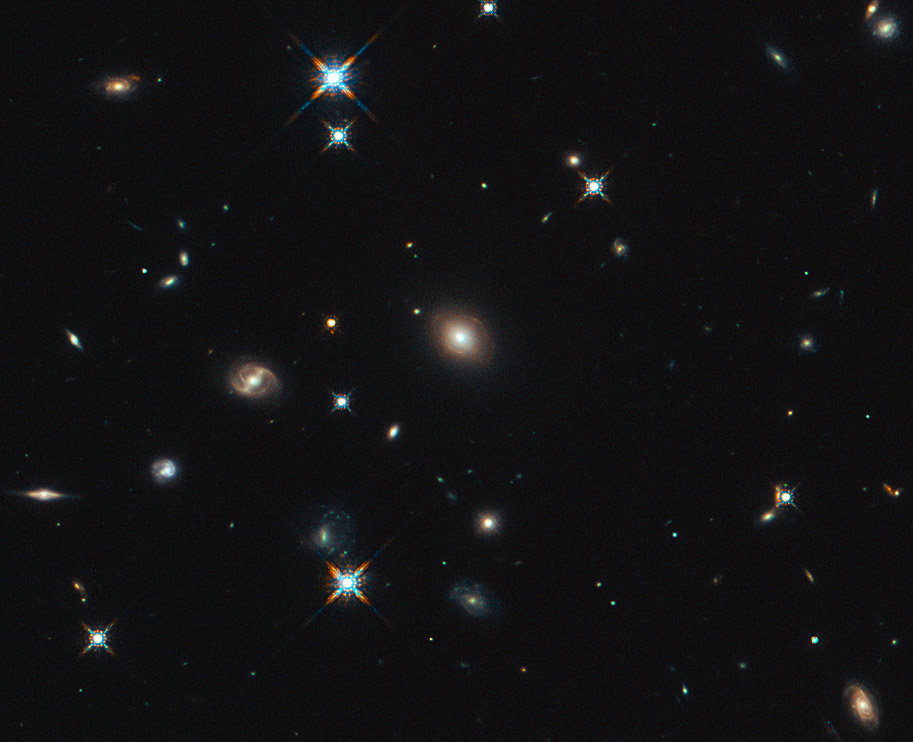Einstein Ring Reveals Explosion of Star Birth in Deep Universe (Video)

The mysteries of star formation in a distant galaxy have been revealed in unprecedented detail, thanks to the twisting and bending of light by gravity.
By pairing the Atacama Large Millimeter/submillimeter Array (ALMA) telescope in Chile with a natural phenomenon known as gravitational lensing, scientists have probed the details of a galaxy 11.4 light-years away with remarkable precision and, in the process, have learned details about its structure, contents, motion and other physical characteristics. ALMA scientists also created a video of the so-called "Einstein ring's" magnifying effect,
"ALMA was designed to be the most powerful telescope of its kind, but by harnessing the magnifying power of this gravitational lens, we were able to study a distant and mysterious object in detail that would have been impossible otherwise," Todd Hunter, an astronomer at the National Radio Astronomy Observatory (NRAO), said in a statement. [65 Amazing Galaxy Images]
"This one data set has spawned an entire series of highly intriguing research, confirming that ALMA offers the astronomical community new avenues to probe the distant universe," said Hunter, who was a co-author of one of seven scientific papers detailing the distant galaxy.
Einstein ring
As part of his theory of general relativity, Albert Einstein theorized that massive objects would bend space and time. Any light that passes through the warped space-time would act as a cosmic magnifying glass — a gravitational lens, he said. When a massive object, such as a galaxy, lines up with a distant object, it creates a special type of gravitational lens known as an Einstein ring.
In the case of this particular galaxy, named HATLAS J090311.6+003906, also known as SDP.81, the Einstein ring allowed scientists to study the background galaxy in remarkable detail. Functioning at its highest resolution, ALMA revealed never-before-seen dusty clouds thought to be clumps of cold molecular gas where stars form.
The telescope also allowed astronomers to measure how the galaxy rotates and to estimate its mass. According to the new research, the gas in SDP.81 is unstable, with clumps collapsing inward. These clumps are likely to create giant new star-forming regions in the future, according to the same statement from the NRAO. The studies also suggest that a supermassive black hole with a mass 200 million to 300 million times that of the sun exists in the center of the foreground galaxy.
Breaking space news, the latest updates on rocket launches, skywatching events and more!
Because it takes a year for light to travel one light-year, looking across the vast distances of space is akin to looking back in time. That means scientists saw the galaxy as it appeared when the universe was only 15 percent of its current age — only 2.4 billion years after the Big Bang, according to the statement.
The European Southern Observatory's (ESO) ALMA telescope, which sits in the Atacama Desert in Chile, consists of 66 individual antennas that can be positioned differently to change the resolution of the entire instrument. For this study, the antennas were at their widest separation, up to 9.3 miles (15 kilometers) apart.
"The reconstructed ALMA image of the galaxy is spectacular," Rob Ivison, ESO's director of science and a co-author of two of the papers, said in the same statement. "We can study galaxies at the other end of the universe as they merge and create huge numbers of stars. This is the kind of stuff that gets me up in the morning!"
The research papers have been submitted to various journals, and four of the studies have been accepted for publication.
Follow us @Spacedotcom, Facebook and Google+. Original article on Space.com.

Nola Taylor Tillman is a contributing writer for Space.com. She loves all things space and astronomy-related, and always wants to learn more. She has a Bachelor's degree in English and Astrophysics from Agnes Scott College and served as an intern at Sky & Telescope magazine. She loves to speak to groups on astronomy-related subjects. She lives with her husband in Atlanta, Georgia. Follow her on Bluesky at @astrowriter.social.bluesky


